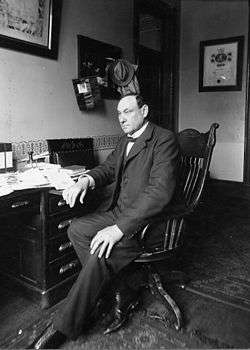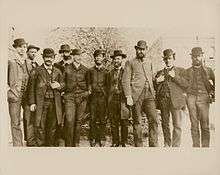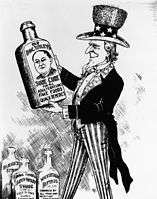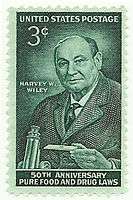Harvey Washington Wiley
| Harvey Washington Wiley | |
|---|---|
|
Harvey Washington Wiley | |
| Born |
Harvey Washington Wiley October 18, 1844 Kent, Indiana |
| Died |
June 16, 1930 (aged 85) Washington, D.C. |
| Resting place |
Arlington National Cemetery 38°52′47.337″N 77°4′34.70″W / 38.87981583°N 77.0763056°W |
| Alma mater |
|
| Occupation |
|
| Years active | 1882 - 1930 |
| Employer |
|
| Organization |
|
| Known for |
|
| Spouse(s) | Anna Kelton |
| Parent(s) |
|
| Awards | Elliott Cresson Medal (1910) |
Harvey Washington Wiley (October 18, 1844 – June 16, 1930) was a noted American chemist best known for his leadership in the passage of the landmark Pure Food and Drug Act of 1906 and his subsequent work at the Good Housekeeping Institute laboratories. He was the first commissioner of the United States Food and Drug Administration. He was awarded the Elliott Cresson Medal of The Franklin Institute in 1910.
Early life and career
Wiley was born on October 18, 1844 in a log farmhouse near Kent, in Jefferson County, Indiana, the son of a farmer. He enrolled in nearby Hanover College in 1863 and studied for about one year until patriotism inspired him to enlist with the Union Army in 1864 as a corporal in Company I of the 137th Regiment Indiana Volunteers during the American Civil War. He returned to Hanover in 1865 where he majored in the humanities and was a top graduate (A.B.) in 1867. He received an A.M. there in 1870. Wiley studied at Indiana Medical College where he received his M.D. in 1871. He was professor of Greek and Latin at Butler College, Indianapolis, 1868-70.[1]
After he graduated, Wiley accepted a position teaching chemistry at the medical college, where he taught Indiana's first laboratory course in chemistry beginning in 1873. Following a brief interlude at Harvard University, where he was awarded a B.S. degree in 1873 after only a few months of intense effort, he accepted a faculty position in chemistry at the newly opened Purdue University in 1874. He was also appointed state chemist of Indiana.
In 1878, Wiley travelled overseas where he attended the lectures of August Wilhelm von Hofmann — the celebrated German discoverer of several organic tar derivatives, including aniline. While in Germany, Wiley was elected to the prestigious German Chemical Society founded by Hofmann. Wiley spent most of his time in the Imperial Food Laboratory in Bismarck working with Eugene Sell, mastering the use of the polariscope and studying sugar chemistry. Upon his return to Purdue, Wiley was asked by the Indiana State Board of Health to analyze the sugars and syrups on sale in the state to detect any adulteration. He spent his last years at Purdue studying sorghum culture and sugar chemistry, hoping, as did others, to help the United States develop a strong domestic sugar industry. His first published paper in 1881 discussed the adulteration of sugar with glucose.
Government career
Wiley was offered the position of Chief Chemist in the United States Department of Agriculture by George Loring, the Commissioner of Agriculture, in 1882. Loring was seeking to replace his chemist with someone who could employ a more objective approach to the study of sorghum, the potential of which as a sugar source was far from proven. Wiley accepted the offer after being passed over for the presidency of Purdue, allegedly because he was "too young and too jovial," unorthodox in his religious beliefs, and also a bachelor. Wiley brought with him to Washington a practical knowledge of agriculture, a sympathetic approach to the problems of agricultural industry and an untapped talent for public relations. [Suzanne White, "Chemistry and Controversy: Regulating the Use of Chemicals in Foods, 1883-1959, unpublished dissertation, Emory University, 1994, pp. 4-5.]
After assisting Congress in their earliest questions regarding the safety of the chemical preservatives then being employed in foods, Wiley was appropriated $5,000 in 1902 to study the effects of a diet consisting in part of the various preservatives on human volunteers. These famous "poison squad" studies drew national attention to the need for a federal food and drug law.
Wiley soon became a crusader and coalition builder in support of national food and drug regulation. His work, and that of Alice Lakey, spurred one million American women to write to the White House in support of the Pure Food and Drug Act.[2]
Wiley was nicknamed the "Father of the Pure Food and Drugs Act" when it became law in 1906. Wiley wrote two editions of Foods and Their Adulteration (1907 and 1911), which detailed the history, preparation and subsequent adulteration of basic foodstuffs to a broad audience. He was also a founding father of the Association of Official Analytical Chemists, and left a legacy to the American pure food movement as its "crusading chemist" that was both broad and substantial.
The fact that enforcement of the federal Pure Food and Drug Act of 1906 was assigned to the Bureau of Chemistry, rather than being assigned to the Department of Commerce or the Department of the Interior, is a tribute to the scientific qualifications which the Bureau of Chemistry brought to the studies of both food and drug adulteration and misbranding. The first food and drug inspectors were hired to complement the work of the laboratory scientists, and an inspection program was launched which revolutionized the country's food supply within the first decade under the new federal law.
Wiley's tenure was marked by controversy over the administration of the 1906 statute which he had worked so hard to secure. Concerns over preserving chemicals, which had not been specifically addressed in the law, continued to be controversial. The Secretary of Agriculture appointed a Referee Board of Consulting Scientists, headed by Ira Remsen at Johns Hopkins University to repeat Wiley's human trials of preservatives. The use of saccharin, bleached flour, caffeine, and benzoate of soda were all important issues which had to be ultimately settled by the courts in the early days under the new law.
Under Wiley's leadership, however, the Bureau of Chemistry grew significantly, both in strength and in stature after assuming responsibility for the enforcement of the 1906 Act. Between 1906 and 1912, Wiley's staff expanded from 110 to 146. Appropriations, which had been $155,000 in 1906 were $963,780 in 1912. The Bureau moved into its own building and used the healing symbol of Aesculapius's staff, or Ophiuchus. In 1911, his enemies urged his dismissal from the Department of Agriculture on the technical charge that an expert in his department had received recompense exceeding the legal rate. But later in the year, President William Howard Taft wrote a letter that fully exonerated Wiley.[1]
On March 15, 1912, Dr. Wiley resigned his leadership of the Chemistry Bureau because, from nearly the beginning, he had been antagonized in the enforcement of the Pure Food And Drugs Act, and worse, he had seen the fundamental principles of that act either paralyzed or discredited.[3] While Taft expressed his regret at Wiley's resignation, according to a Daily Princetonian article published on March 16, 1912, the then Agriculture Secretary, James Wilson, spoke highly, as stated in the same article, of how "valuable" Wiley had been, and in turn, Wiley thanked Wilson for the "personal kindness and regard shown him."
Work at Good Housekeeping
After his resignation from government work in 1912, Wiley took over the laboratories of Good Housekeeping Magazine, where he continued his work on behalf of the consuming public. His disapprobation of “drugged” products included cola drinks; he warned against the caffeine in them vehemently. In a famous action he brought against the Coca-Cola Company in 1911, he contended that it was illegal to use the name Coca-Cola when there was no actual cocaine in the drink, and also that it was illegal for it to contain caffeine as an additive. Perversely, this was as much as to say that the product ought to have contained cocaine and not caffeine. Still, the case was a landmark in developing standards for truth in labeling. The beverage continued to be brewed, even as of late September 2016, with de-cocaine-ized coca leaves and cola nuts.
He remained with Good Housekeeping for 18 years.
Death
Harvey Wiley died at his home in Washington, D.C. on June 30, 1930, the 24th anniversary of the signing of the Pure Food and Drug law. He is buried in Arlington National Cemetery with his wife Anna Kelton Wiley (1877–1964) whom he married in 1911.
Legacy
Harvey W. Wiley has been honored in a number of ways since his passing:
The Liberty Ship S.S. Harvey W. Wiley was one of 2751 World War II Liberty Ships built between 1941 and 1945. She was a tanker laid down September 15, 1943, launched October 15, 1943, sold by the government in 1947, and scrapped in 1969.
The U.S. Post Office issued a 3 cent postage stamp in Wiley's honor on June 27, 1956, in conjunction with the 50th anniversary of the 1906 Act.
The Harvey W. Wiley Award is AOAC International's most prestigious scientific award established in 1956 and presented annually since 1957 to a scientist (or group of scientists) who have made an outstanding contribution to analytical method development in an area of interest to AOAC International. AOAC International was originally founded in 1884 as the Association of Official Agricultural Chemists. Wiley as a founding member, President in 1886, Secretary from 1889 to 1912, and Honorary President until his death in 1930.
Wiley has several buildings named in his honor. Wiley was honored by Hanover College with a "Wiley Residence Hall" inaugurated in 1956. He was also honored by Purdue University in 1958 when the "Harvey W. Wiley Residence Hall" was opened northwest of the main academic campus. The FDA's Center for Food Safety and Applied Nutrition (CFSAN) operations are located in the Harvey W. Wiley Federal Building in College Park, MD, constructed in 2001, and named after Wiley in 2002.
His birthplace near Kent is commemorated with an Indiana historic marker sign placed at the corner of IN-256 & CR-850W. The marker was sponsored by the Association of Food and Drug Officials and erected in 1981.
The French government named him a Chevalier of the Order of the Légion d'honneur in 1909.
The Harvey Washington Wiley Distinguished Professor of Chemistry is an honor established through the Chemistry department at Purdue University. The position has been occupied since 1997 by Dr. Dale W. Margerum.
The home he built at Somerset, Maryland in 1893, the Wiley-Ringland House, was listed on the National Register of Historic Places in 2000.[4]
| Depictions of Harvey W. Wiley and advocation for the U.S. Pure Food and Drug Laws | ||||||||
|---|---|---|---|---|---|---|---|---|
|
Publications
- The Sugar Industry of the United States. 1885.
- —; U.S. Department of Agriculture, Division of Chemistry (1887). Bulletin No. 13. Foods and Food Adulterants, Part First: Dairy Products. Washington: Government Printing Office. Retrieved 2009-08-01. Cite uses deprecated parameter
|coauthors=(help) - Principles and Practice of Agricultural Analysis. 1894-7; revised edition, 1906-14. Check date values in:
|date=(help) - —; U.S. Department of Agriculture, Division of Chemistry (1904). Bulletin No. 84, Part I. Influence Of Food Preservatives And Artificial Colors On Digestion And Health. I. Boric Acid and Borax. Washington: Government Printing Office. Retrieved 2009-08-01. Cite uses deprecated parameter
|coauthors=(help) - — (1914). 1001 Tests Of Foods, Beverages And Toilet Accessories, Good And Otherwise: Why They Are So. New York: Hearst's International Library Co. Retrieved 2009-08-01.
- The Lure of the Land. 1915.
- — (1915). Not By Bread Alone: The Principles of Human Nutrition. New York: Hearst's International Library Co. Retrieved 2009-08-01.
- — (1917). Foods And Their Adulteration: Origin, Manufacture,And Composition Of Food Products; Infants' and Invalids' Foods; Detection Of Common Adulterations (3rd ed.). Philadelphia: P. Blakiston's Son & Co. Retrieved 2009-08-01.
- — (1917). Wiley's Health Services Book One: Nutrition, Hygiene, Physiology. Chicago: Rand McNally & Company. Retrieved 2009-08-01.
- — (1917). Wiley's Health Services Book Two: Nutrition, Hygiene, Physiology. Chicago: Rand McNally & Company. Retrieved 2009-08-01.
- — (1917). Wiley's Health Services Book Three: Nutrition, Hygiene, Physiology. Chicago: Rand McNally & Company. Retrieved 2009-08-01.
- — (1919). Beverages And Their Adulteration: The Origin, Composition, Manufacture, Natural, Artificial, Fermented, Distilled, Alkaloidal, And Fruit Juices. Philadelphia: P. Blakiston's Son & Co. Retrieved 2009-08-01.
- Wiley, Harvey W. (1930). "Harvey W. Wiley, An Autobiography." Bobbs Merrill Company, Indianapolis.
He also edited a series of Health Readers for Schools in 1919.
See also
References
- 1 2
 Chisholm, Hugh, ed. (1922). "Wiley, Harvey Washington". Encyclopædia Britannica (12th ed.). London & New York.
Chisholm, Hugh, ed. (1922). "Wiley, Harvey Washington". Encyclopædia Britannica (12th ed.). London & New York. - ↑ "Alice Lakey (1857-1935)". Alice Lakey. Outstanding Women of Cranford, NJ.
- ↑
- "Harvey Wiley Explains Resignation" (PDF). The Daily Princetonian. Associated Press. March 16, 1912. p. 1. Archived from the original on March 2009.
President Taft expressed his regret at the resignation. Secretary Wilson said that Wiley had been a "valuable man." Wiley thanked Wilson for the "personal kindness and regard shown him."
- "Harvey Wiley Explains Resignation" (PDF). The Daily Princetonian. Associated Press. March 16, 1912. p. 1. Archived from the original on March 2009.
- ↑ National Park Service (2008-04-15). "National Register Information System". National Register of Historic Places. National Park Service.
- Notes
 This article incorporates public domain material from the United States Government document "http://www.fda.gov/aboutfda/whatwedo/history/centennialoffda/harveyw.wiley/default.htm".
This article incorporates public domain material from the United States Government document "http://www.fda.gov/aboutfda/whatwedo/history/centennialoffda/harveyw.wiley/default.htm".- Allyn, Lewis B. (February 1915). "Pure Food In The United States". McClure's. XLVI (4): 78. Retrieved 2009-07-31.
- Dunn, Arthur Wallace (September 1911). "Dr. Wiley And Pure Food, First Article: A Twenty-Year's Fight, The Long Struggle Against "Influence" To Enact The Law, The Harder Struggle To Enforce It, An Amazing Story of Obstruction". The World's Work: A History of Our Time. XXII: 14958–14965. Retrieved 2009-07-10.
- Dunn, Arthur Wallace (November 1911). "Dr. Wiley And Pure Food, Second Article: The Chief Of The Bureau Of Chemistry As Washington Knows Him". The World's Work: A History of Our Time. XXIII: 29–40. Retrieved 2009-07-10.
- Dye, Charity (1917). Some Torch Bearers In Indiana. Indianapolis: The Hollenbeck Press. pp. 208–213. Retrieved 2009-08-01.
- Francis, F.J. (2000). "Harvey W. Wiley: Pioneer in Food Science and Quality." In A Century of Food Science. Chicago: Institute of Food Technologists. pp. 13–14.
- Fisher, Carl D. (March 1909). "Editorial: Dr. Wiley And The Pure Food Laws". Progress. VIII (4): 91–94. Retrieved 2009-08-01.
- Kettle, William (January 30, 1909). "Shall The Special Interests Rule?". La Follette's Magazine. XCI: 225–227. Retrieved 2009-08-01.
- Stealey, Orlando Oscar (1910). 130 Pen Pictures Of Live Men. New York: Publishers Printing Company. pp. 457–461. Retrieved 2009-08-01.
- Shaw, Arch Wilkinson (June 1907). "In The Business Eye: To Enforce The New Pure Food Laws". System: the Magazine of Business. XI (VI): 650. Retrieved 2009-08-01.
- "Dr. Harvey W. Wiley, of Indiana, Class of 1871 of the Indiana Medical College". Indiana Medical Journal. XXV (11): 446–448. May 1907. Retrieved 2009-08-01.
- Bellamy, Francis Rufus (January 30, 1909). "Pure Food and Decent Food". The Outlook. XCI: 225–227. Retrieved 2009-08-01.
- Association, Indiana State Medical (August 15, 1911). "Editorial Notes". The Journal of the Indiana State Medical Association. IV (8): 348–. Retrieved 2009-08-01.
- Association, Texas Medical (August 1911). "Dr. Wiley To Be Investigated". Texas State Journal of Medicine. VII (4): 109–. Retrieved 2009-08-01.
- Smith, Alfred Emanuel (September 23, 1911). "The Exoneration Of Dr. Wiley". The Outlook. XCIX: 147–148. Retrieved 2009-08-01.
- ), Academy of Political Science (U.S; Faculty Of Political Science, Columbia University; York, Academy of Political Science in the City of New (December 1911). "Record Of Political Events From May 1 to November 7, 1911: July 12". Political Science Quarterly. XXVI (4): 741. Retrieved 2009-08-01.
External links
| Wikimedia Commons has media related to Harvey Washington Wiley. |
| Wikisource has original works written by or about: Harvey Washington Wiley |
- Harvey W. Wiley: Pioneer Consumer Activist, from the January–February 2006 issue of FDA Consumer magazinex
- http://www.thecrusadingchemist.com, the official website of The Crusading Chemist screenplay by Amanda Read
- "Harvey Washington Wiley". Author, Chemist, Social Reformer. Find a Grave. October 12, 1999. Retrieved March 3, 2013.
- Dr. Harvey "Old Borax" Wiley and his Poison Squad, from the Indiana Historical Bureau




